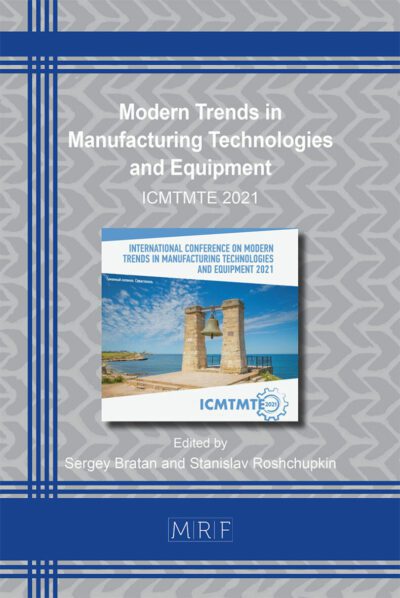Investigations into the processing and texture of Pr-substituted NdFeB magnets produced by extrusion
RÜDIGER Alexander, GALL Sven, MÜLLER Sören
download PDFAbstract. Crystallographically and magnetically textured but dimensionally limited NdFeB permanent magnets produced by hot deforming processes such as die-upsetting and back-extrusion have been extensively researched in the past [1]. In order to investigate the possibility of producing longer magnets which can subsequently be cut to the required length, the extrusion of permanent magnets was investigated as a further hot deformation process. For this purpose, the process control with regard to the tools used as well as the process parameters were modified from the common forming processes for extrusion. Therefore, a praseodymium-substituted NdFeB powder was encapsulated in steel and extruded by varying the extrusion ratio (9.9:1 & 13.9), the billet insert temperature (800°C & 850°C) and the extrusion speed (0.6 – 10.5 mm/s). In addition, the glass lubrication system was changed during the experiments. Since the resulting magnetic properties for hot deformation depend on the produced anisotropy, texture analyses were also carried out in the first step by means of X-ray diffraction on the cross-sections of the produced strands. For the parameter variation, strands could be realized with the applied concept. However, cracks were found in the magnetic material for all tests. Based on the texture analyses, anisotropy could be generated in the magnet material for all strands.
Keywords
Pr/NdFeB, Anisotropic Magnets, Extrusion, Hot Deformation
Published online 4/19/2023, 10 pages
Copyright © 2023 by the author(s)
Published under license by Materials Research Forum LLC., Millersville PA, USA
Citation: RÜDIGER Alexander, GALL Sven, MÜLLER Sören, Investigations into the processing and texture of Pr-substituted NdFeB magnets produced by extrusion, Materials Research Proceedings, Vol. 28, pp 505-514, 2023
DOI: https://doi.org/10.21741/9781644902479-55
The article was published as article 55 of the book Material Forming
![]() Content from this work may be used under the terms of the Creative Commons Attribution 3.0 license. Any further distribution of this work must maintain attribution to the author(s) and the title of the work, journal citation and DOI.
Content from this work may be used under the terms of the Creative Commons Attribution 3.0 license. Any further distribution of this work must maintain attribution to the author(s) and the title of the work, journal citation and DOI.
References
[1] O. Gutfleisch, Controlling the properties of high energy density permanent magnetic materials by different processing routes, J. Phys. D: Appl. Phys. 33 (2000). https://doi.org/10.1088/0022-3727/33/17/201
[2] N.A. Dormidontov, A.G. Dormindontov, A.S. Lileev, A.V. Kamynin, A.A. Lukin, Effect of partial substitution of neodymium with praseodymium on the magnetic and process properties of sintered magnets of type NdFeB, Metal Sci. Heat Treat. 58 (2017) 608-613. https://doi.org/10.1007/s11041-017-0064-6
[3] S. Hirosawa, Y. Matsuura, H. Yamamoto, Magnetization and magnetic anisotropy of R2Fe14B measured on single crystals, J. Appl. Phys. 59 (1986) 873-879. http://doi.org/10.1063/1.336611
[4] I. Poenarua, A. Lixandrua, S. Riegg, Ce and La as substitutes for Nd in Nd2Fe14B-based melt-spun alloys and hot-deformed magnets: a comparison of structural and magnetic properties, J. Magn. Magn Mater. 478 (2019) 198-205. https://doi.org/10.1016/j.jmmm.2019.01.095
[5] Y. Une, M. Sagawa, Enhancement of coercivity of Nd-Fe-B sintered magnets by grain size reduction, J. Japan Inst. Met. Mater. 76 (2012) 12-16.
[6] J. Liu, H. Sepehri-Amin, T. Ohkubo, Grain size dependence of coercivity of hot-deformed Nd–Fe–B anisotropic magnets, Acta Mater. 82 (2015) 336-343. https://doi.org/10.1016/j.actamat.2014.09.021
[7] L. Li, C.D. Graham, Mechanism of texture formation by hot deformation in rapidly quenched FeNdB, J. Appl. Phys. 67 (1990) 4756-4758. https://doi.org/10.1063/1.344776
[8] R.K. Mishra, E.G. Brewer, R.W. Lee, Grain growth and alignment in hot deformed Nd-Fe-B magnets, J. Appl. Phys. 63 (1988) 3528-3530. https://doi.org/10.1063/1.340731
[9] R. Shioi, H. Miyawaki, T. Morita, Orientation mechanism of hot-deformed anisotropic RE-Fe-B magnets, Denkiseiko 82 (2011) 31-37.
[10] R.K. Mishra, T.Y. Chu, L.K. Rabenberg, The development of the microstructure of die-upset Nd-Fe-B magnets, J. Magn. Magn. Mater. 84 (1990) 88-94. https://doi.org/10.1016/0304-8853(90)90168-P
[11] J. Liu, H. Sepehri-Amin, T. Ohkubo, Microstructure evolution of hotdeformed Nd-Fe-B anisotropic magnets, J. Appl. Phys. 115 (2014) 17A744. https://doi.org/10.1063/1.4867960
[12] R.K. Mishra, Microstructure of hot-pressed and die-upset NdFeB magnets, J. Appl. Phys. 62 (1987) 967-971.
[13] Information on http://www.shinetsu-rare-earth-magnet.jp/e/masspro/
[14] M. Bauser, G. Sauer, K. Siegert, Strangpressen, Aluminium-Verlag, Düsseldorf, 2 Edition, 2001

































